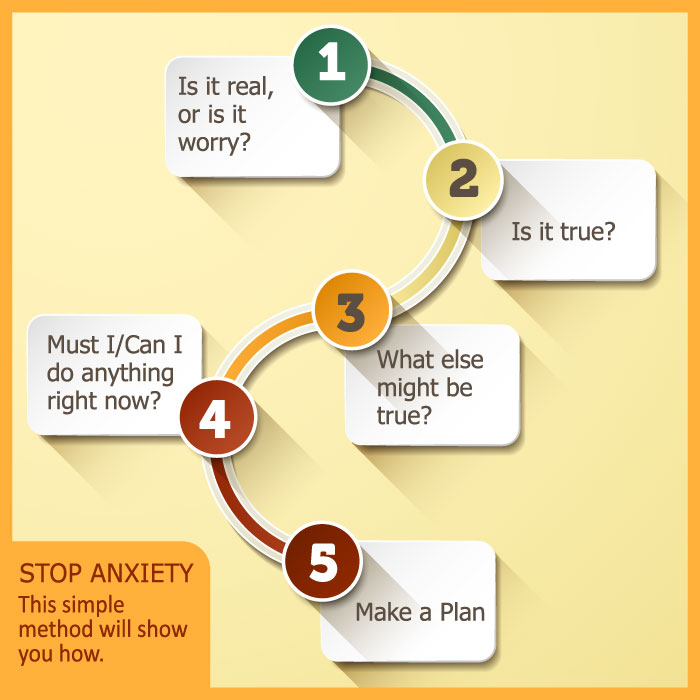If you are a persistent person – and if you’re reading this blog, you probably are – then you know the power of focusing on something intensely until it gets done.
Unfortunately, the brain with the power to hone in relentlessly on solving a problem or achieving a goal is often the same brain that grabs onto a negative thought or a fear and can’t let that go either. If you ever find your brain spinning incessantly on an unproductive thought, no matter how hard you try to stop focusing on it, this method will help you.
Step 1: Is it real, or is it worry?
Obviously, if you are in the middle of an IRS audit, it’s real. If it’s real, skip to Step 4. But most of the time, our unproductive thoughts are worries, resentments, and fears. If you identify that the thing you are spinning on is not real, go to Step 2.
Step 2: Is it true?
It’s very tempting to believe that all our thoughts are true, but they’re not. The mind plays games with us, and we often waste time believing in things that aren’t real at all.
For example, I have a client who is likely the most experienced person alive in his field. He’s amazing. But when he sees other people in his field — people who have significantly less talent and experience than him — being asked to make presentations or take interviews as the expert, it really bothers him. When I asked him to articulate what it was about this that upset him so much, he said, “They think so-and-so is the expert instead of me.” So when I asked him, “Is that true?” he thought about it for a bit and then said, “I guess I don’t know.” So we talked about all the other reasons those other people might be asked to do things, each reason as plausible (or even more plausible) than his initial belief.
Our assumptions are based on a lot of things. We assume we know what others think or feel, we assume we know all the details of a situation, we assume we have more (or less) knowledge than we really have. Our assumptions become our realities, and many of them are simply false. By asking ourselves the question is it true, we gain the perspective that comes from stepping back and questioning our assumptions.
Step 3: What else might be true?
Make a list of all the other possible explanations for or interpretations of your worry. Once you see the entire list of alternative explanations and outcomes for your particular worry, you’ll start to feel better instantly. The human brain is a very logical mechanism. Actively focusing on a broader range of possibilities will almost always stop the spinning.
Step 4: Do I need to do anything about this right now?
Chances are, you don’t, or can’t. Even if you are in the middle of an IRS audit, there’s really nothing you can change about the past, and you simply need to wait until the IRS asks for more information, or tells you what they’ve determined, before you can take a next step.
Of course, in most cases, there’s nothing more to do because the thought wasn’t real in the first place, and by now you’ve identified several other explanations that are equally plausible.
Step 5: What should I do right now?
Make a plan. Whether that plan is to actively improve something related to the worry, or whether that plan is to proceed without worrying is irrelevant. The point is to do something positive and productive and get on with your day.
Does this seem too simple to work? There’s good brain science behind it. The brain will grab onto a detail and chew on it relentlessly in the absence of better information. By working through these five steps, you feed your brain more intelligence – more data – to stop the spinning and point your arrows in a forward direction again.
But don’t take my word for it. Try it out the next time you get stuck. You'll love being able to stop anxiety and get on with your day.











